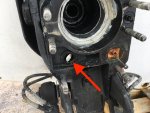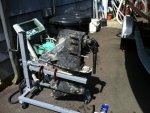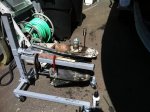- Joined
- Jul 18, 2011
- Messages
- 18,840
UPDATE:
I found something when I took the outdrive off . . .

That turned out to be a sea shell that apparently grew inside the outdrive water duct and then dislodged and got stuck that the fitting for the intake tube. Not 100% sure this was the source of that problem, but it does fit the symptoms.
I'll be running the engines today with a hose adapter into the bell housing. If I get favorable and comparable ECT results between the two engines, then it might be case closed for this.
I had a similar problem on the F-242 . . . a whole barnacle grew inside the outdrive duct and dislodged, ending up in pretty much the same place. The only difference was that being a complete barnacle, it restricted the flow even more than what this sea shell appears to have done.
I found something when I took the outdrive off . . .

That turned out to be a sea shell that apparently grew inside the outdrive water duct and then dislodged and got stuck that the fitting for the intake tube. Not 100% sure this was the source of that problem, but it does fit the symptoms.
I'll be running the engines today with a hose adapter into the bell housing. If I get favorable and comparable ECT results between the two engines, then it might be case closed for this.
I had a similar problem on the F-242 . . . a whole barnacle grew inside the outdrive duct and dislodged, ending up in pretty much the same place. The only difference was that being a complete barnacle, it restricted the flow even more than what this sea shell appears to have done.
























